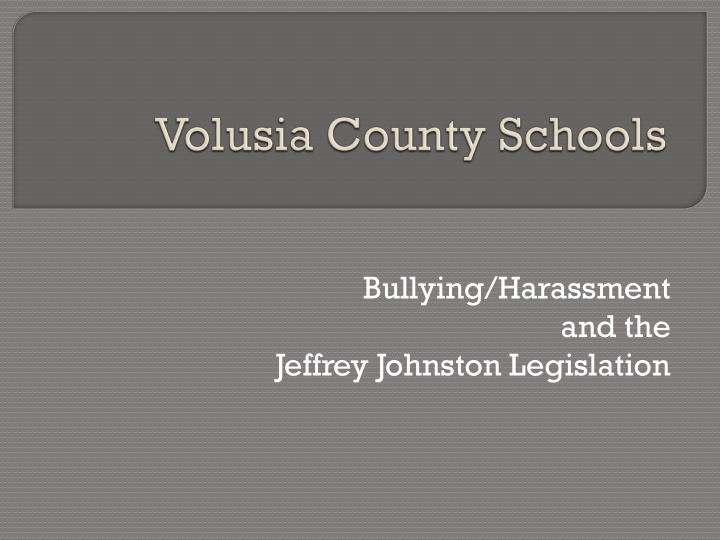



Bullying/Harassment and the Jeffrey Johnston Legislation
An act relating to school safety; prohibiting bullying and harassment of any student or employee of a public K-12 educational institution; providing definitions; requiring each school district to adopt a policy prohibiting such bullying and harassment. 2
“Bullying” is defined as systematically and chronically inflicting physical hurt or psychological distress on one or more students and may involve: Teasing; Social exclusion; Threat; Intimidation; Stalking; Physical violence; Theft; Sexual, religious, or racial harassment; Public humiliation; or Destruction of property.
“Harassment” is defined as any threatening, insulting, or dehumanizing gesture, use of data or computer software, or written, verbal, or physical conduct directed against a student or school employee that: ❖ Places a student or school employee in reasonable fear of harm to his or her person or damage to his or her property. ❖ Has the effect of substantially interfering with a student’s educational performance, opportunities, or benefits. ❖ Has the effect of substantially disrupting the orderly operation of a school.
Bullying - Policy 525 • Bullying for the purpose of this policy is defined as systematically and chronically inflicting physical or psychological distress on one or more student or employees. The term bullying shall include “cyber - bullying” . • It is further defined as unwanted and repeated written, verbal, or physical behavior, including any threatening, insulting or dehumanizing gesture by a student or adult, that is severe or pervasive enough to create an intimidating, hostile or offensive educational environment; cause discomfort or humiliation or unreasonable interfere with the individual’s school performance or participation.
Harassment- Policy 525 • Harassment for the purpose of this policy, shall be defined as any threatening, insulting, or dehumanizing gesture, use of data or computer software, or written, verbal or physical conduct directed against a student or school employee that: Places a student or employee in reasonable fear of harm to his or her person or damage to his or her property. Has the effect of substantially interfering with a student’s educational performance, opportunities, or benefits Has the effect of substantially disrupting the orderly operation of a school.
Code of Conduct- Policy 208 • Bullying is defined as aggressive behavior that is repeated, that is intentionally harmful and occurs with no provocation. This includes teasing, calling names, hitting, kicking, stealing, threatening as well as spreading rumors and influencing others to do these things. This includes cyber-bullying where technology and cyberspace are used for any of the above behaviors and acts.
Procedure in place for anonymous reporting Procedures in place to Investigate and Document bullying and harassment. Paperwork to be completed by School Administrators to document and investigate reports of bullying and harassment. Constant communication with parents. All reports of bullying will be investigated and documented through Crosspointe and SESIR.
N ORMAL C ONFLICT VS. B ULLYING
Post student expectations related to bullying in common areas & in each classroom. Additional awareness campaigns can be conducted through contests or PSAs on your morning news.
“Good schools are proactive and deal with bullying promptly, firmly, and fairly. Bad schools deny it, ignore it, rationalize it, handle it inappropriately, sweep it under the carpet, blame the victim of bullying, blame the parents of the victim of bullying, or make lots of impressive noises but take no substantive action.” Bullying in American Schools (2003) by Anne G. Garrett
As of August 13, 2013 the VCS School Board approved updates to Policy 525 to comply with new changes to state law under HB 609 (July 1, 2013). The policy now further prohibits bullying or harassment through the use of data or computer software that is accessed at a nonschool-related location, activity, etc. or through the use of technology or an electronic device that is not owned, leased, or used by a school district or school if it: Substantially interferes with or limits educational ability to participate, or Substantially disrupts the education process or orderly operation of a school
Recommend
More recommend